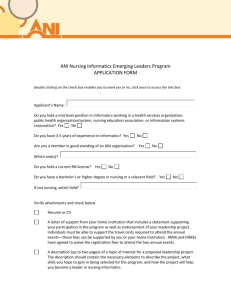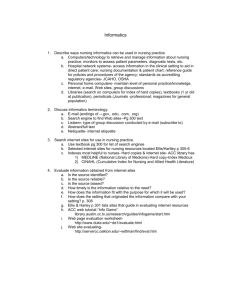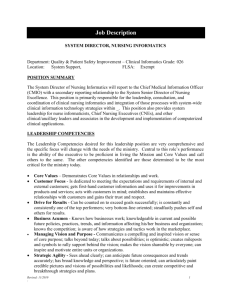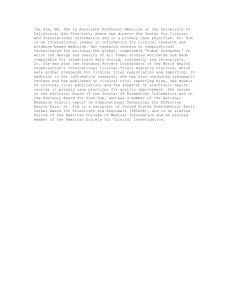NursingInformatics_lec
advertisement
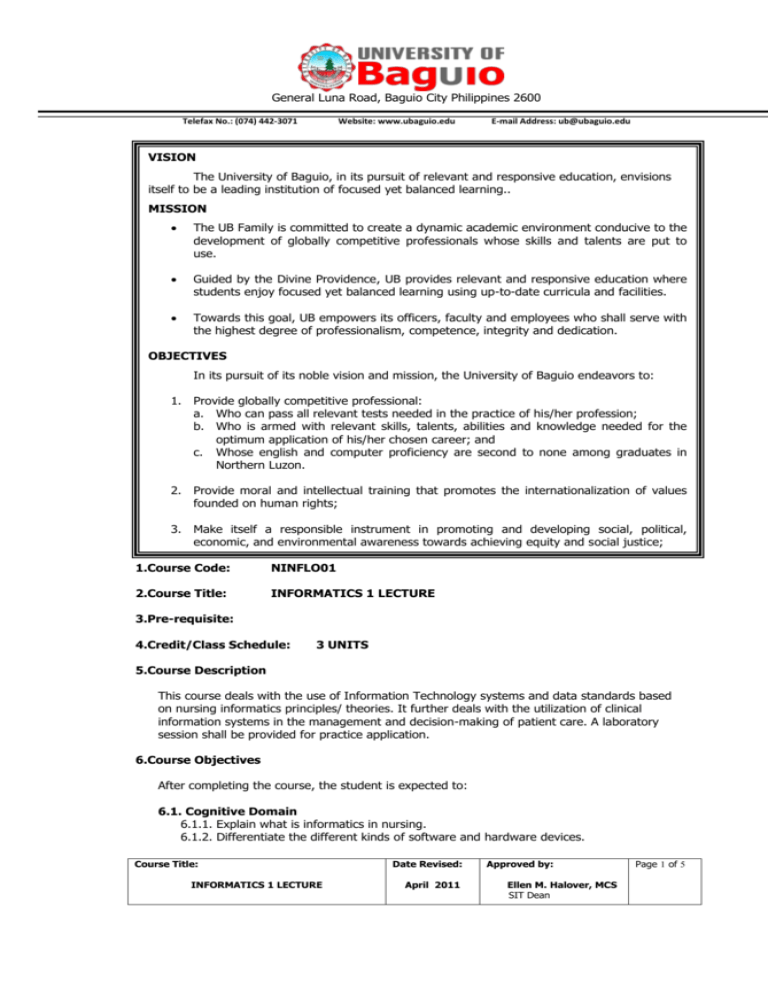
General Luna Road, Baguio City Philippines 2600 Telefax No.: (074) 442-3071 Website: www.ubaguio.edu E-mail Address: ub@ubaguio.edu VISION The University of Baguio, in its pursuit of relevant and responsive education, envisions itself to be a leading institution of focused yet balanced learning.. MISSION The UB Family is committed to create a dynamic academic environment conducive to the development of globally competitive professionals whose skills and talents are put to use. Guided by the Divine Providence, UB provides relevant and responsive education where students enjoy focused yet balanced learning using up-to-date curricula and facilities. Towards this goal, UB empowers its officers, faculty and employees who shall serve with the highest degree of professionalism, competence, integrity and dedication. OBJECTIVES In its pursuit of its noble vision and mission, the University of Baguio endeavors to: 1. Provide globally competitive professional: a. Who can pass all relevant tests needed in the practice of his/her profession; b. Who is armed with relevant skills, talents, abilities and knowledge needed for the optimum application of his/her chosen career; and c. Whose english and computer proficiency are second to none among graduates in Northern Luzon. 2. Provide moral and intellectual training that promotes the internationalization of values founded on human rights; 3. Make itself a responsible instrument in promoting and developing social, political, economic, and environmental awareness towards achieving equity and social justice; 1.Course Code: NINFLO01 2.Course Title: INFORMATICS 1 LECTURE 3.Pre-requisite: 4.Credit/Class Schedule: 3 UNITS 5.Course Description This course deals with the use of Information Technology systems and data standards based on nursing informatics principles/ theories. It further deals with the utilization of clinical information systems in the management and decision-making of patient care. A laboratory session shall be provided for practice application. 6.Course Objectives After completing the course, the student is expected to: 6.1. Cognitive Domain 6.1.1. Explain what is informatics in nursing. 6.1.2. Differentiate the different kinds of software and hardware devices. Course Title: INFORMATICS 1 LECTURE Date Revised: April 2011 Approved by: Ellen M. Halover, MCS SIT Dean Page 1 of 5 6.1.3. 6.1.4. 6.1.5. Enumerate and discuss the types of Information systems and applications being used by healthcare practitioners. Enumerate and discuss the different practice applications. Analyze the different issues involved in Informatics. 6.2. Affective Domain 6.2.1. Show awareness of the importance of information technology in the formation of a digital society and healthcare practitioners. 6.2.2. Participate actively in class discussions. 6.2.3. Practice cooperation in group activities. 6.3. Psychomotor Domain 6.3.1. Make a sample list of Clinical decision support system. 6.3.2. Search the web for nursing resources. 6.3.3. List landmark events in nursing and computers. 6.3.4. Construct a simple clinical information system. 6.3.5. Construct a simple OASIS assessment form. 6.3.6. Create a case analysis on the different informatics applications. 7. Course Coverage NO. OF HOURS METHODOLOGY/ STRATEGY Course Syllabus VMO Seat Plan Grading System Safety Leveling of Expectations 1 Class Discussion Introduction 1 Internet/ Library Research Assignment TOPIC Computers and Nursing Overview of Computers and Nursing Historical perspective of nursing and the computers Electronic health record from a historical perspective Computer System Hardware The System Unit: Processing and Memory Data and program representation The System Unit and its arrangement The CPU its function and components Improving System Performance Storage Storage System Characteristics Magnetic Disk Systems Optical Disk Systems Flash Memory Systems Other Types of Storage Devices Input and Output Types of Input Devices Types of Output Devices Software System Software Operating System Utility Programs Application Software Basics of Application Software Examples of Application Software Course Title: INFORMATICS 1 LECTURE EVALUATION TOOLS Graded Recitation Quiz 2 Research then Group Presentation Class discussion facilitated by the Instructor Quiz 2 Internet/ Library Research Class discussion Quiz 2 Internet/ Library Research Class discussion Lecture and Class Discussion Library/Internet research work Group Dynamics Quiz 2 Date Revised: April 2011 Group Activities, Graded Recitation Quiz Approved by: Ellen M. Halover, MCS SIT Dean Page 2 of 5 The Internet: A nursing resource Evolution of the Internet Internet Tools for Advanced Nursing Practice Censorship and Privacy Issues Issues in Informatics Nursing Informatics and Healthcare Policy The Role of Technology in the Medication-use Process Healthcare Data Standards Electronic Health Record Systems Dependable Systems for Quality Care Nursing Minimum Data Set Systems MIDTERM EXAMINATION Informatics Theory Theories, Models, and Frameworks Advanced Terminology System Implementing and Upgrading Clinical Information Systems Use of Computer-based Clinical Decision Support System for Health Professionals Information Management for Nurses' Practice Practice Application Practice Application Critical Care Applications Community Health Applications Ambulatory Care Systems Informatics Solutions for Emergency Preparedness and Response Vendor Applications Consumers' Use of Informatics Consumer and Patient Use of Computer for Health Decision Support for Consumer International Perspective Nursing Informatics in Canada Nursing Informatics in Europe Nursing Informatics in Pacific Rim Nursing Informatics Asia Nursing Informatics in South America The Future of Informatics Future Vision of NI in the 1st Decade of 21st Century Key Scientific Influences on the Future of Informatics FINAL EXAMINATION 3 Internet Research Class discussion Group Activities Graded Group Activities, Recitation and Quiz 4 Research then Group Presentation and Class discussion facilitated by the Instructor Quiz Recitation 1.5 Case Analysis Quiz 3 Internet/ Library Research Class Discussion Reporting 3 Internet/ Library Research Class Discussion Group Role Playing 3 Internet/ Library Research Class Discussion 3 Internet/ Library Research Class Discussion Group Dynamics QUIZ 2 Class Discussion Assignment 1.5 8. Course Requirements Research papers Assignment Library and internet research works Presentation slides and group presentation delivery Case Analysis Major examinations 9. Textbook/Manual Saba, Virginia and McCormick, Kathleen. Essentials of Nursing Informatics 4th Edition, Course Title: INFORMATICS 1 LECTURE Date Revised: April 2011 Approved by: Ellen M. Halover, MCS SIT Dean Page 3 of 5 International Edition,McGraw-Hill Co, Inc. 2006 10. Course Evaluation The highest percentage rating that may be given in any grading period is 99 and the lowest passing grade is 75. Any grade lower than 75 is considered “Failed”. An incomplete mark should be completed within one month from start of class in the subsequent term otherwise such incomplete grade will become NC (no credit). Towards the computation of student’s grades in any subject, the following are done: 1.The student’s actual total score, which refers to the sum of the student’s scores in quizzes, assignments, projects, recitation, seatwork, examination, etc, is determined. 2.The student’s actual score is transmuted using the distribution table based on the highest possible score.(note: the instructor will show the distribution table to the students) There are three (3) grading periods (first grading, midterms & finals) during regular semesters and two(2) grading period (midterms and finals) during summer. The cumulative system of computing grades shall be followed. Grades computed for midterms and finals are considered tentative. The final midterm grade is calculated by getting 1/3 of the first grading grade plus 2/3 of the tentative midterm grade and the final grade is computed by getting 1/3 of the midterm grade plus 2/3 of the tentative final grade. 11. Other Course Policies 11.1. Attendance Attendance is checked from the first day of classes. Students who miss classes due to late enrolment shall be marked absent for the day(s) missed. A student who comes to class 10-15 minutes shall be marked “tardy”. Three (3) tardy marks are equivalent to one hour of absence. A student who leaves the classroom and stays out for the duration of the class period without the instructor’s permission shall be marked “absent”. A student who incurs absences of more than twenty percent (20%) of the prescribed number of class or laboratory periods during the semester shall be dropped automatically and given a failing grade. 11.2. Examination The policy of “No permit, No exam” shall be strictly enforced. 11.3. Assignments Assignments are due at the beginning of the class period. Late assignments, which are passed within the class period, are worth 50% credit. 11.4. Medium of Instruction With the vision of becoming an English Speaking University, classroom lectures, discussions, consultations, and other ways of communication, may it be written or oral, must be in English. 11.5. Conduct The formation of character is one of the most important features of the education system at the University. For this reason, the imposed discipline, while observant of the rights and feeling of others, is firm, especially when the reputation of the student body and institution is at stake. Students are expected to manifest, both within and outside the University, the respect for order, morality, personal honor, and rights of others, which is required of Christian men and women. For this course the code of conduct is that there will be NO plagiarism and NO cheating. Course Title: INFORMATICS 1 LECTURE Date Revised: April 2011 Approved by: Ellen M. Halover, MCS SIT Dean Page 4 of 5 11.6. Consultation Schedule Consultation schedules with the instructors are posted on ICT bulletin boards. It is advised that the student first set an appointment to confirm the instructor’s availability. Get the student consultation form at the Dean’s Office. The instructor will not entertain a student without it. 12. References Books Cashman, et al. Essential Introduction to Computers, 7th Edition, Course Technology, 2007 Morley, Deborah. Understanding Computers: Today & Tomorrow, 11th Edition, Course Technology, 2007 O’Brien, James A. Introduction to Information Systems, Essentials for the Internetworked Enterprise 9th Edition, Irwin/McGraw-Hill Companies, Inc. 2000 Shelley, et al. Discovering Computers 2008: Study Guide, Course Technology, 2007 Tocci, Ronald, Digital Systems-Principles and Applications 8th Edition, Prentice Hall International. 2001 Whitten, et al. Systems Analysis and Design Methods – 6th Edition, The Mc-Graw Hill Companies, 2004 Internet www. blueclaw-db.com/software_risk_assessment.htm www.pesmpc1.vub.ac.be/ASC/SYSTEM_ANALY.html www.se.cuhk.edu.hk/~seg3430/2005/tutorial/tutorial04.pdf www.tvcc.cc.or.us/staff/fuller/cs244/lecture.htm www.umsl.edu/~sauter/analysis/analysis_links.html 13. Prepared by: COMPTR Committee Members 14. Approved by: Ellen M. Halover, MCS SIT Dean Course Title: INFORMATICS 1 LECTURE Date Revised: April 2011 Approved by: Ellen M. Halover, MCS SIT Dean Page 5 of 5
